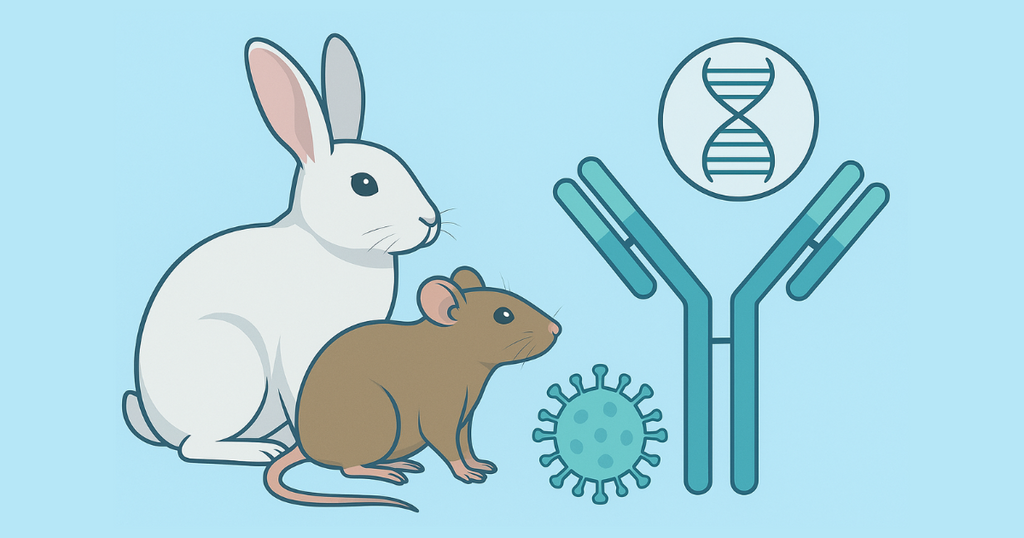The Immunological Edge of Rabbit-Derived Antibodies
In the development of therapeutic antibodies and diagnostic reagents, rabbit-derived antibodies are increasingly becoming a gold-standard tool. Compared to traditional mouse-derived antibodies, rabbit antibodies demonstrate higher affinity, broader epitope recognition, and superior stability. These advantages stem from fundamental differences in the immune systems of rabbits and mice. This article explores the biological superiority of rabbit antibodies from the perspective of their distinct immunological mechanisms.
I. The Diversity Engine of the B-Cell Repertoire: Rabbit-Specific Genetic Recombination
Rabbits possess unique mechanisms for antibody diversification. Although they have far
fewer V (variable region) gene segments than mice (rabbits have ~100 V genes, whereas mice have hundreds), they achieve exceptional diversity through gene conversion and somatic hypermutation (SHM):
1. The "Training Camp" in Young Rabbits’ Gut-Associated Lymphoid Tissue (GALT)
The cecal lymphoid tissue in young rabbits serves as a specialized site for B-cell diversification. Here, B cells interact with commensal microbes, initiating V gene diversification. This early immune stimulation ensures that the rabbit antibody repertoire develops broad specificity even before full maturation.
2. Gene Conversion: The Remix Strategy
Rabbit B cells use upstream V gene segments as templates, copying and pasting sequences into functional V genes via enzyme-mediated DNA recombination. This mechanism, akin to a genetic jigsaw puzzle, generates combinations far exceeding the original genomic diversity.
Comparison: Mice rely primarily on random V(D)J recombination, with only minor SHM adjustments later, resulting in a lower diversity ceiling.
II. Epitope Recognition with a Wide-Angle Lens: Superior Detection of Conformational Epitopes
Rabbit antibodies excel at recognizing conformational epitopes (3D structural motifs), whereas mouse antibodies tend to target linear epitopes. This difference arises from:
1. Structural Features of the Antigen-Binding Site
Rabbit antibody CDR3 regions are, on average, 2-3 amino acids longer than those in mice, forming more complex spatial structures that can "clamp" onto the 3D contours of antigens.
2. A More Permissive Epitope Selection Strategy
Studies show that rabbit B cells tolerate antigen surface irregularities (e.g., grooves or protrusions) better, enabling them to generate antibodies against complex structural motifs. In contrast, mouse B cells favor flat, linear regions.
Practical Impact: In studies of GPCRs (G-protein-coupled receptors), rabbit-derived antibodies show a 40% higher success rate than mouse-derived ones.
III. Affinity Maturation on Fast-Forward: High Mutation Rates Drive Superior Binding
Rabbit germinal centers feature a unique microenvironment that accelerates antibody
refinement:
1. The Molecular Basis of Hypermutation
Rabbit activation-induced cytidine deaminase (AID) exhibits ~30% higher activity than its murine counterpart, leading to mutation rates of up to 10⁻³ per base per generation (compared to 10⁻⁴ in mice). This allows high-affinity antibodies to emerge even after a single immunization.
2. Long-Term Immune Memory and Continuous Optimization
Rabbit memory B cells can persist in the bone marrow for years, undergoing ongoing mutation and selection. Antibodies generated from a single immunization can increase in affinity by 1,000-fold over six months.
Case in Point: In COVID-19 research, rabbit-derived neutralizing antibodies achieved dissociation constants (K_D) as low as 10⁻¹¹ M, two orders of magnitude stronger than typical mouse antibodies (10⁻⁹ M).
IV. Post-Translational Quality Control: The Stability Advantage
Rabbit IgG Fc regions exhibit distinct glycosylation patterns:
1. Higher Galactosylation Levels
Rabbit antibodies have ~60% α-1,3 galactosylation (vs. 20% in mice), reducing aggregation and enhancing thermal stability (rabbit antibodies retain function 3x longer at 56°C).
2. Extra Disulfide Bonds for Structural Integrity
An additional inter-heavy-chain disulfide bond (absent in mice) makes rabbit antibodies more resistant to freeze-thaw cycles and harsh pH conditions.
Conclusion: Nature’s Evolutionary Gift to Science
The rabbit immune system has evolved a highly efficient antibody production "assembly line" through unique strategies. Understanding these mechanisms not only aids in selecting the right research tools but also inspires bioengineered antibody design. With advancements like single B-cell cloning, rabbit-derived antibodies are now breaking new ground in cancer immunotherapy and beyond, proving their irreplaceable value.

